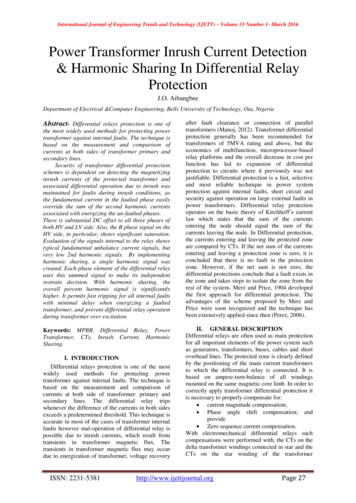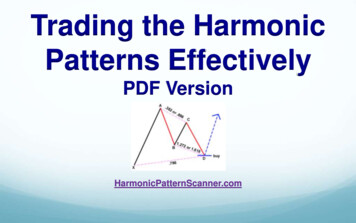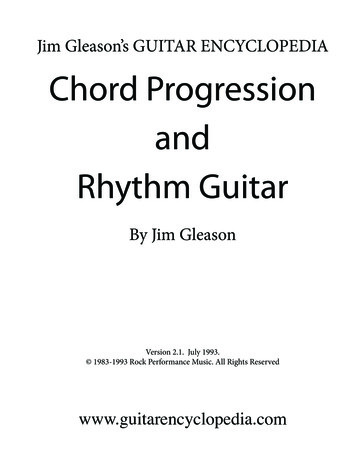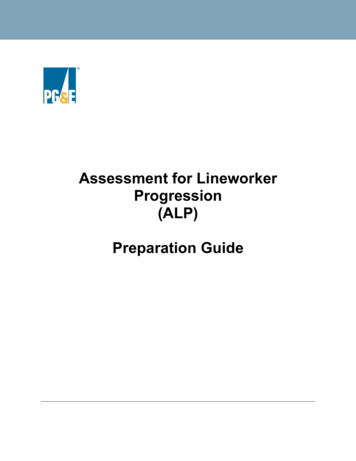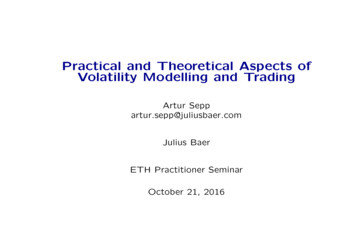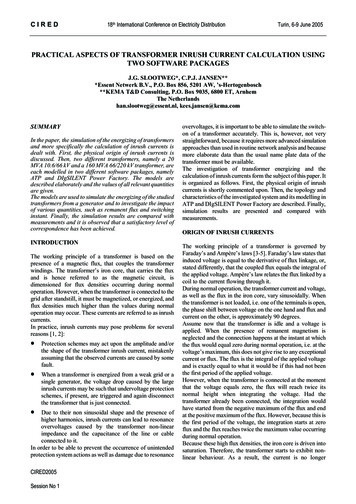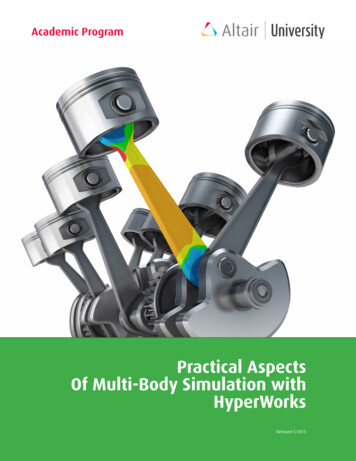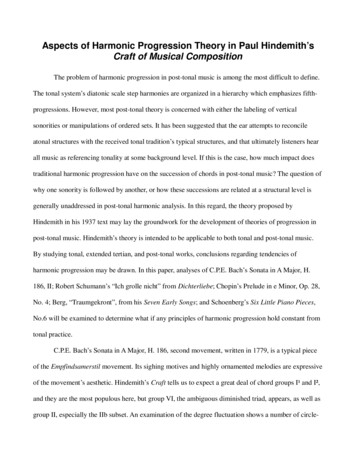
Transcription
Aspects of Harmonic Progression Theory in Paul Hindemith’sCraft of Musical CompositionThe problem of harmonic progression in post-tonal music is among the most difficult to define.The tonal system’s diatonic scale step harmonies are organized in a hierarchy which emphasizes fifthprogressions. However, most post-tonal theory is concerned with either the labeling of verticalsonorities or manipulations of ordered sets. It has been suggested that the ear attempts to reconcileatonal structures with the received tonal tradition’s typical structures, and that ultimately listeners hearall music as referencing tonality at some background level. If this is the case, how much impact doestraditional harmonic progression have on the succession of chords in post-tonal music? The question ofwhy one sonority is followed by another, or how these successions are related at a structural level isgenerally unaddressed in post-tonal harmonic analysis. In this regard, the theory proposed byHindemith in his 1937 text may lay the groundwork for the development of theories of progression inpost-tonal music. Hindemith’s theory is intended to be applicable to both tonal and post-tonal music.By studying tonal, extended tertian, and post-tonal works, conclusions regarding tendencies ofharmonic progression may be drawn. In this paper, analyses of C.P.E. Bach’s Sonata in A Major, H.186, II; Robert Schumann’s “Ich grolle nicht” from Dichterliebe; Chopin’s Prelude in e Minor, Op. 28,No. 4; Berg, “Traumgekront”, from his Seven Early Songs; and Schoenberg’s Six Little Piano Pieces,No.6 will be examined to determine what if any principles of harmonic progression hold constant fromtonal practice.C.P.E. Bach’s Sonata in A Major, H. 186, second movement, written in 1779, is a typical pieceof the Empfindsamerstil movement. Its sighing motives and highly ornamented melodies are expressiveof the movement’s aesthetic. Hindemith’s Craft tells us to expect a great deal of chord groups I¹ and I²,and they are the most populous here, but group VI, the ambiguous diminished triad, appears, as well asgroup II, especially the IIb subset. An examination of the degree fluctuation shows a number of circle-
2progression patterns (root motion by descending fifths). Measures 8-9 show a brief passage of parallelgroup I² chords, culminating with a tonic I¹ chord.Harmonically, tonicization of the fourth scale-step is problematic for Hindemith’s theory, as theprivileging of the fifth suggests that IV has greater import than it does aurally (measures 5-6,12-13,18-20). While the A tonality, and later the F-sharp, are structurally more significant, a simplereading of root motion would seem to suggest that the D has an importance that is not supported by acareful listening. Tonicizations such as these should be compared to the score before drawing deeperconclusions. Progressions in this piece follow the Series 2 guidelines, generally. Root movement byfifths and fourths is common, stepwise root motion is less frequent, and usually as a precursor to fifthbased movement. Third-movement is infrequent, seen in sequential patterns (connecting fifths by step,as in measures 6-7, and 18-19) and in the gaps between phrases in new tonalities (mm. 5 and 14-15).These root motions are the common gestures of the tonal practice, and this piece exemplifies thatpractice.Schumann’s Ich grolle nicht, dating from 1840, is separated from the Bach sonata by sixtyyears. In this time, harmonic practice had expanded and evolved, but the generalities of harmonicprogression were mostly unchanged. Root motion by fifths predominates, although the tendency toobscure this root motion has increased. The bass and root have become more dissociated, the use ofpedals and common tones making the bass more linear and melodic than functional. The use of groupIII harmonies has increased, especially III², and harmonic fluctuation is smoother than in the Bach. Agradual increase and decrease in tension is seen, rather than the sudden spike and drop of the group VIchords in the Bach. Root motion by fifths is still the most common progression, although the species ofchords have expanded. Mediant relations are more common and step progressions are infrequent. Theuse of mediant relation chords becomes more common in the Romantic era, and Schumann emphasizes
3the common tones between these chords.Chopin’s e minor prelude Op. 28, No. 4, is laden with chords difficult to analyze in traditionalterms. Many of these chords arise as unprepared or unresolved nonharmonic tones appear. Stepprogressions play a role in this, as the accompanimental chords move almost entirely by downwardstep. As the bass descends to the fifth of the key, other voices move at different rates, giving the linearmotion primacy over harmonic motion. The separation of bass and root functions is taken further here,and the continual stepwise motion emphasizes this. The harmonic language is more diverse than in theSchumann song, and ambiguous group VI chords are more frequent. The question of whether to treateach vertical structure as a new chord or to treat some harmonies as contrapuntal, arising from voiceleading and containing nonharmonic tones is difficult to answer. The melodic line can determine theclassification somewhat. For example, taking the C5 in the melody (mm.1-2) as an upper neighbortone, and not a chord member, allows for a more regular harmonic rhythm. This is complicated in m. 3,where the C is consonant to the group IIb² chord. Group II chords form an important part of theharmonic ambiguity in this piece, especially those chords that form half-diminished sevenths, oralternately, minor chords with added sixths. Hindemith reads them as the latter, with the fifth of theminor triad as the “best” element. The use of step progressions in each voice further divorcesfunctionality from bass motion, as each line’s stepwise descent blurs the vertical sonorities. Theprinciples outlined by Hindemith's theory for progression are generally upheld here, most rootmovement is by fifths, less frequently by thirds, and in few passages, by seconds. Harmonic fluctuationshows that, as in previous examples, a gradual increase in tension (in this piece usually from groups Iand II to III, IV, or VI) is followed by a resolution to group I chords. Although the chord roots centeraround E, the first coincidence of root and bass on E occurs only at measure 21.These three works exemplify a tonal application of Hindemith’s theory and show the typical
4harmonic progressions of tonal music. Roots move generally by fifths, movement by seconds or thirdsserves as an approach to movement by fifths, as at cadence points. Chords beyond groups I, II, or IIIare rare, with the exception of group VI diminished seventh chords, which grow in prominence as thetonal language expands. Generally, nonharmonic tones are easily recognizable, and the decision toexclude certain pitches from the chordal analysis can be justified easily from tonal contexts. Tonalcenters are created, as Hindemith saw it, from the reinforcement of certain root motions and scaledegrees. This is clearly demonstrated in the pieces analyzed above. As the language of tonalitydissolves in the works of the Second Viennese School, can these principles of progression be upheld?Some theorists have read atonal or post-tonal harmony as distant extensions of tonal principles. FromProkofiev’s “wrong notes” to Schoenberg’s atonal avoidance of thirds and fifths, the lack of surfacereferences belies the ultimately tonal way we listen to music, and the way we attempt to reconcile theseharmonic structures with common practice harmony.Berg’s Seven Early Songs skirt the edges of atonality. They predate his study with Schoenberg,but demonstrate a looser tonality than the preceding Chopin. “Traumgekront” has a key signature oftwo flats, but a panoply of accidentals, blurring the tonal center. The few major triads (chord group I¹)are embroidered with appogiaturas and chromatic passing figures. Suspensions and syncopated basslines obscure the progressions. No root progression by fifths occur, but plagal cadences abound, as doprogressions by seconds. A common harmonic ploy is a sequence of different chord groups with thesame root, which is then repeated at another pitch level. This is seen at mm. 2-3, and the analogouspassage at mm. 17-18. Again, harmonic tension builds gradually, in combination with the commonroots, and secundal progressions. A C tonality is eventually established, and the piece closes on a Gchord (group I¹).Schoenberg’s Op. 19, No. 6 Klavierstücke, composed in 1911, predates his serial technique, and
5consists entirely of chords from groups III and IV. While in a tonal context, these harmonies would bepoints of great tension, the group III harmonies provide moments of relaxation in this setting. Thisalmost aphoristic piece, while containing only one root motion by fifth (at measure 5), shows in itsfluctuation the same gradual building and dissipation that the Chopin prelude did. Harmonically, thetendency to hear bass notes as roots is confounded in the Hindemith analysis. Measure 5’s final beat, agroup IV² chord with F as its root, looks in the score, and sounds to the ear as an altered dominantchord on E, the bass note. The resolution in measure 6 to a different chord of the same group, and withthe same theoretical root prolongs the ambiguity. This same confusion of root and bass occurs in thefinal measure. The sonority (from bass to treble) is [8 T 7 0 5 9 6 E]. The A-flat, being the final pitchheard as well as the lowest pitch, takes on the character of a possible root. However, the B-flat thatprecedes it is the actual root in a Hindemithian reading. In either case, it provides a less thansatisfactory cadence, ending on a group IV² chord, with a greater tension than the preceding measure.This may be an intended effect, as the piece was composed on the day of Mahler’s funeral, andSchoenberg was a notoriously emotion-driven composer. The root movement suggests an underlying Bflat center. The first quasi-cadential point, at m. 6, is rooted on F; the final chord, at m. 9, is rooted onB-flat, a fifth relation. However, not much else reinforces this possibility, as the first five measuresvacillate between chords rooted on B-natural and C, before reaching the group IV² chord on F at theend of m. 5. Although the root motion of the Hindemithian reading and the aural perception of rootmotion may disagree, one aspect that holds true is the fluctuation pattern. Even in an explicitly nontonal framework, Schoenberg is treating less dissonant harmonies as points of release. The threestrophes of the composition end with group IV² chords, and begin with group III² chords. Theprogress to the close of each phrase is characterized by a gradual increase in density and dissonance,even within a chord group.
6A subtle step progression appears in this piece, extending from the initial B5 through the wholeof the piece and closing on A-flat1 in the final measure. This progression, again, should not beconstrued as a Schenkerian Urlinie. The Hindemithian step progression is a structural scalar line, but isnot necessarily tied to function.It appears in these analyses that root motion of a second, especially a minor second, becomesmore common in the Second School’s work, as the fifth-based root motion fades away. Chords of groupI are almost entirely absent, appearing in the early Berg song only as heavily embellished sonorities,laden with suspensions, appoggiaturas, and escape tones. Chords of group III are more common, and inthe Schoenberg seem to “replace” the major or minor triad as a lull in harmonic tension.In these analyses, it can be seen that the fifth-based root motion that Hindemith privilegesbecomes less dominant (as it were), and secundal motion gains prominence. The principles of harmonicfluctuation remain viable, even in the aphoristic context of the Schoenberg piece. The idea of a tonalcenter being defined by the root motions surrounding it is difficult to reconcile in this context. Thetendency to hear the bass note of a complex chord as its root occasionally conflicts with the calculatedroot; sometimes only slightly, as in the case of half-diminished seventh chords, which can be dealtwith, even in traditional terms as nearly equal analyses, but in other cases, such as the cadence point inthe Schoenberg, the root (F) conflicts dramatically with the aurally perceived root (E). However, incombination with set theory, Schenkerian analysis, and aural analysis, identification of both percievedand calculated roots, and of structural sonorities is possible. Having determined these elements, it maybe possible to combine multiple analyses to develop a more thorough theory of harmonic progressionin post-tonal music.
7
9
BibliographyBerg, Alban. Seven Early Songs. Vienna: Universal Edition, 1928.Hindemith, Paul. The Craft of Musical Composition, Vol. I: Theory. Translated by Arthur Mendel. 4thed., New York: Associated Music Publishers, 1937.Neumeyer, David. The Music of Paul Hindemith. Binghamton, NY: Vail-Ballou Press, 1986.Palisca, Claude V., ed. Norton Anthology of Western Music, Vol. 2. New York: Norton, 1996.Plantinga, Leon, ed. Anthology of Romantic Music. New York: Norton, 1984.Turek, Ralph, ed. Analytical Anthology of Music. New York: McGraw-Hill, 1992.
The problem of harmonic progression in post-tonal music is among the most difficult to define. The tonal system’s diatonic scale step harmonies are organized in a hierarchy which emphasizes fifth-progressions. However, most post-tonal theory is concerned with either the labeling of vertical sonorities or manipulations of ordered sets. It has been suggested that the ear attempts to reconcile
